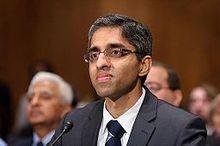Hospitalist Vivek Murthy, 37, Confirmed as U.S. Surgeon General
He has aged a year since President Obama nominated him for U.S. Surgeon General in November 2013, but on Monday Boston hospitalist Vivek Murthy, MD, was confirmed as the highest physician in America.
According to multiple sources, Dr. Murthy’s outspoken support for stricter gun laws and belief that guns are a public health issue delayed his confirmation due to opposition from the National Rifle Association (NRA), which in a letter to Senate leadership in February said Dr. Murthy’s confirmation would be a “prescription for disaster for America’s gun owners.”
Despite this, Senate Democrats approved his four-year appointment in a 51-43 vote that cut along party lines. In his confirmation hearing in February, Dr. Murthy said he does not “intend to use the surgeon general’s office as a bully pulpit for gun control.”
Dr. Murthy, 37, earned his medical and business degrees from Yale and for the last decade has worked as both an internist and a hospitalist at Brigham and Women’s Hospital in Boston. He is the youngest Surgeon General ever, and the first of Indian-American descent.
“On behalf of America’s 44,000 hospitalists, I congratulate Dr. Murthy, a fellow hospitalist and one of our SHM members, on his historic appointment to U.S. Surgeon General,” says Society of Hospital Medicine President Burke Kealey, MD, SFHM. “Being America’s doctor requires many of the same traits required of hospitalists: leadership, sharp clinical skills, and the ability to engage with patients. And, like hospitalists in thousands of hospitals across the country, I am confident Dr. Murthy will become an agent of change to improve delivery of care in our country.”
In 2008, Dr. Murthy founded Doctors for Obama, a non-profit, grassroots organization of 16,000 physicians and medical students dedicated to transforming the healthcare system. After the election, he changed the name of the organization to Doctors for America. He also started the software company TrialNetworks in 2007 to aid in drug development, and, in 1995, he started an HIV and AIDS education non-profit in India called VISIONS Worldwide.
In a statement from the White House Monday, President Obama applauded the Senate for Dr. Murthy’s confirmation, saying: “Vivek’s confirmation makes us better positioned to save lives around the world and protect the American people here at home.”
Dr. Murthy replaces acting Surgeon General Boris Lushniak, who took over when Regina Benjamin resigned in July 2013. The surgeon general is the U.S.’ top spokesperson on all matters of public health and oversees the 6,700 members of the U.S. Public Health Service Commissioned Corps.
Kelly April Tyrrell is a freelance writer in Madison, Wis.



